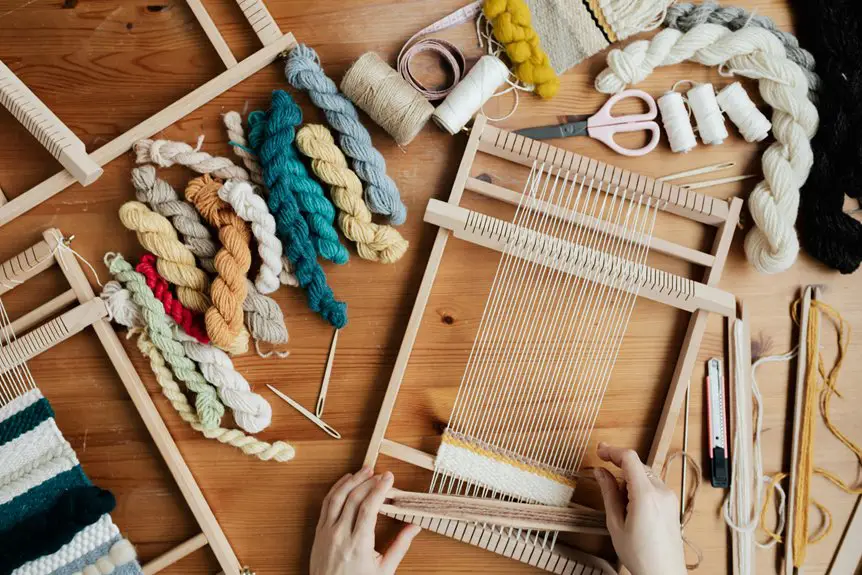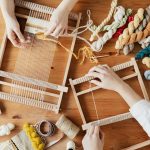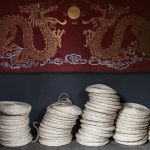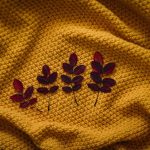Tapestry fabric is a rich, woven textile traditionally made from wool, cotton, or silk, featuring intricate patterns created by weaving colored weft threads over a loom’s warp threads. You’ll find it historically used for wall hangings that insulate and decorate, and today, it adds artistic flair to home decor like cushions and upholstery, as well as fashion accessories like jackets and bags. If you want to explore its history, craftsmanship, and versatile style uses, there’s plenty more to discover.
Table of Contents
Key Takeaways
- Tapestry fabric is a woven textile featuring intricate designs created by interlacing colored weft threads over warp threads on a loom.
- Traditionally made from wool, cotton, or silk, tapestry fabric offers rich texture, warmth, and vibrant colors for decorative purposes.
- It differs from embroidery as the design is woven into the fabric, not stitched on top, producing durable, story-telling textiles.
- Common uses include wall hangings, upholstery, cushions, throws, and fashion items like jackets and handbags for artistic flair.
- Proper care involves gentle cleaning, avoiding direct sunlight, rotating to prevent fading, and storing in cool, dry places.
History and Origins of Tapestry Fabric
Although tapestry fabric has ancient roots, its rich history still captivates people today.
You’ll find that tapestries began as practical wall hangings in ancient civilizations like Egypt and Mesopotamia, serving to insulate cold stone walls.
As you explore further, you’ll see that during the Middle Ages, tapestries became symbols of wealth and power, often commissioned by royalty and nobility to depict historical events or religious scenes.
When you look at Renaissance Europe, you’ll notice how tapestry art reached new heights, blending storytelling with intricate craftsmanship.
Materials Commonly Used in Tapestry Weaving
When you start weaving a tapestry, choosing the right materials is key.
You’ll find natural fibers like wool and cotton offer warmth and texture, while synthetic fibers bring durability and vibrant colors.
Understanding these options helps you create a tapestry that fits your style and needs.
Natural Fibers Overview
You’ll find that three natural fibers—wool, cotton, and silk—dominate tapestry weaving due to their durability and texture.
Wool offers excellent elasticity and warmth, making it ideal for tapestries that need to hold dye well and maintain shape over time.
Cotton provides a smooth, strong base that’s easy to work with and allows vibrant colors to stand out.
Silk, though pricier, adds a lustrous sheen and delicate softness, perfect for intricate designs requiring fine detail.
When you choose these fibers, you’re selecting materials that have stood the test of time in textile arts.
Each fiber interacts differently with light and dye, so picking the right one lets you control the final look and feel of your tapestry.
Natural fibers also breathe better, enhancing the tapestry’s longevity and appeal.
Synthetic Fibers Benefits
Since synthetic fibers offer unique advantages, many tapestry weavers choose them alongside natural materials.
You’ll find fibers like nylon, polyester, and acrylic popular because they’re durable, resistant to fading, and less prone to shrinking or stretching. These qualities help your tapestry maintain its shape and color over time, especially in high-traffic or sunlit areas.
Synthetic fibers also tend to be more affordable and easier to clean, which is great if you want low-maintenance art. Plus, they can mimic the look and feel of natural fibers while adding strength and flexibility.
The Weaving Techniques Behind Tapestry Fabric
Several weaving techniques shape the unique texture and design of tapestry fabric.
When you explore tapestry weaving, you’ll notice it relies heavily on the weft-faced weaving method, where the weft threads cover the warp threads completely. This approach lets you create detailed images and patterns.
Tapestry weaving uses weft-faced techniques to fully cover warp threads, enabling intricate images and patterns.
You’ll also encounter techniques like slit weaving, where small gaps form between color blocks, enhancing the design’s sharpness. Another important method is interlocking, which joins different colored wefts together, preventing gaps and adding durability.
As you work on a tapestry, you use a loom to hold the warp threads tight, allowing you to weave the weft threads precisely.
Mastering these techniques helps you achieve the rich, intricate look that makes tapestry fabric so distinctive.
How Tapestry Differs From Other Textile Arts
When you compare tapestry to embroidery, you’ll notice tapestry is woven directly on a loom, creating rich textures through interlaced threads.
Embroidery, on the other hand, adds designs on top of fabric, which changes the technique and feel.
Understanding these differences helps you appreciate the unique craftsmanship behind tapestry fabric.
Weaving Vs Embroidery
Although both weaving and embroidery involve creating designs with thread, they differ fundamentally in technique and purpose.
When you weave tapestry, you interlace threads on a loom, building the design as part of the fabric itself. Embroidery, on the other hand, adds decorative stitches onto an existing piece of cloth. This means tapestry is integral to the fabric’s structure, while embroidery decorates its surface.
When you choose tapestry over embroidery, you experience:
- A rich, durable fabric that tells a story woven into every thread.
- The satisfaction of seeing your design emerge as you work the loom.
- A timeless art form that connects you to centuries of craftsmanship.
Understanding this difference helps you appreciate tapestry’s unique role in textile arts.
Texture and Technique Differences
Understanding how tapestry differs from embroidery sets the stage for exploring its unique texture and techniques.
When you work with tapestry, you’re weaving colored threads directly into the fabric’s structure, creating a thick, durable surface with a slightly raised, textured feel. Unlike embroidery, which adds decorative stitches on top of a fabric, tapestry integrates its design within the fabric itself. This means you don’t just see the pattern on the surface—you feel it.
You’ll notice tapestry uses weft threads densely packed to form images or patterns, while embroidery relies on needlework layering. This difference makes tapestry ideal for large, pictorial artworks and upholstery, offering both visual depth and physical substance you won’t get from other textile arts.
Popular Designs and Motifs in Tapestry Fabric
Since tapestry fabric often serves as a statement piece, its designs and motifs play an essential role in defining its character.
When you explore tapestry, you’ll find rich imagery that tells stories, evokes history, and sparks imagination.
Popular motifs often include:
- Floral and botanical patterns that bring nature’s beauty indoors, adding warmth and life.
- Mythological and historical scenes that transport you to another era, creating a sense of mystery and grandeur.
- Geometric and abstract shapes that offer a modern twist while maintaining classic weaving techniques.
These designs don’t just decorate; they connect you to tradition and artistry.
Choosing tapestry fabric means embracing a piece of culture that resonates with emotion and craftsmanship, making any space uniquely yours.
Modern Applications of Tapestry in Home Decor
Tapestry fabric brings a unique blend of texture and artistry to modern home decor, making it a versatile choice for various applications.
You can use tapestry as striking wall hangings that add character and warmth to any room. It works beautifully as upholstery fabric, revitalizing chairs or sofas with intricate patterns that draw the eye.
Consider tapestry cushions or throws to introduce subtle elegance without overwhelming your space. You might also incorporate tapestry into window treatments or lampshades for a distinctive touch.
Its durability allows you to create statement rugs or table runners that combine function with style.
Caring for and Maintaining Tapestry Fabric
When you bring tapestry fabric into your home, keeping it in great condition guarantees its beauty lasts for years. Tapestries are delicate, so treating them with care preserves their intricate designs and rich textures.
Caring gently for your tapestry ensures its delicate beauty and intricate details endure over time.
Avoid harsh cleaning methods and direct sunlight, which can fade colors and weaken fibers. Instead, follow these tips:
- Gently vacuum with a brush attachment to remove dust without damaging threads.
- Spot clean stains immediately using a mild detergent and a soft cloth.
- Rotate your tapestry occasionally to prevent uneven fading or wear.
Using Tapestry Fabric in Fashion and Accessories
If you’ve ever wanted to add a touch of vintage charm or artistic flair to your wardrobe, tapestry fabric offers a unique solution. You can use it to create statement pieces like jackets, skirts, or handbags that instantly stand out.
Its rich patterns and textured feel give your accessories an elegant, handcrafted look. When you wear tapestry fabric, you showcase both creativity and timeless style. It’s especially great for adding depth to simple outfits or making bold fashion statements.
Just remember, tapestry fabric is sturdy but can be heavy, so it works best in structured items rather than flowing garments. Whether you’re crafting a one-of-a-kind bag or a standout vest, tapestry fabric lets your personal style shine through with artistic flair.
Tips for Choosing and Buying Quality Tapestry Fabric
Although selecting tapestry fabric might seem straightforward, knowing what to look for can save you time and guarantee you get the best quality.
When choosing tapestry fabric, pay close attention to the weave tightness, as a dense weave guarantees durability and vivid designs. Also, examine the fiber content; natural fibers like wool or cotton offer better texture and longevity.
Finally, consider the design’s vibrancy—colors should be rich and consistent, reflecting expert craftsmanship.
Keep these tips in mind:
- Look for even, tight weaving that feels sturdy.
- Choose natural fibers for a soft, lasting fabric.
- Pick colors that pop and resist fading.
Frequently Asked Questions
Can Tapestry Fabric Be Recycled or Repurposed Sustainably?
Imagine a worn tapestry transformed into vibrant cushions; you can recycle or repurpose it sustainably by upcycling into home décor or patchwork projects. Don’t let its beauty fade—give your tapestry fabric a second life.
How Long Does It Typically Take to Weave a Tapestry?
You can expect weaving a tapestry to take anywhere from several weeks to months, depending on its size and complexity. You’ll need patience and skill since detailed designs demand more time and careful attention.
Are There Specific Tools Required for Tapestry Weaving?
Yes, you’ll need specific tools like a loom, tapestry needles, a heddle, and a shuttle. These help you weave efficiently and create detailed designs. Don’t forget scissors and a tapestry comb to tidy your work!
Can Tapestry Fabric Be Used Outdoors Without Damage?
Think of tapestry fabric as a delicate flower—beautiful but sensitive. You can’t leave it out in the rain without it wilting. So, don’t use it outdoors unless it’s specially treated to resist damage.
What Are Common Mistakes to Avoid When Working With Tapestry Fabric?
Don’t skip pre-washing; tapestry fabric can shrink. Avoid harsh detergents and heavy ironing, which damage fibers. Use sharp scissors to prevent fraying and always handle it gently to keep the weave intact and vibrant.
- Tetron Fabric for Marine Applications: Durability and Use Cases - June 18, 2025
- Tetron Fabric for Outdoor Furniture: Weather Resistance and Care - June 18, 2025
- Tetron Fabric for Wall Coverings: Style and Application Tips - June 18, 2025







